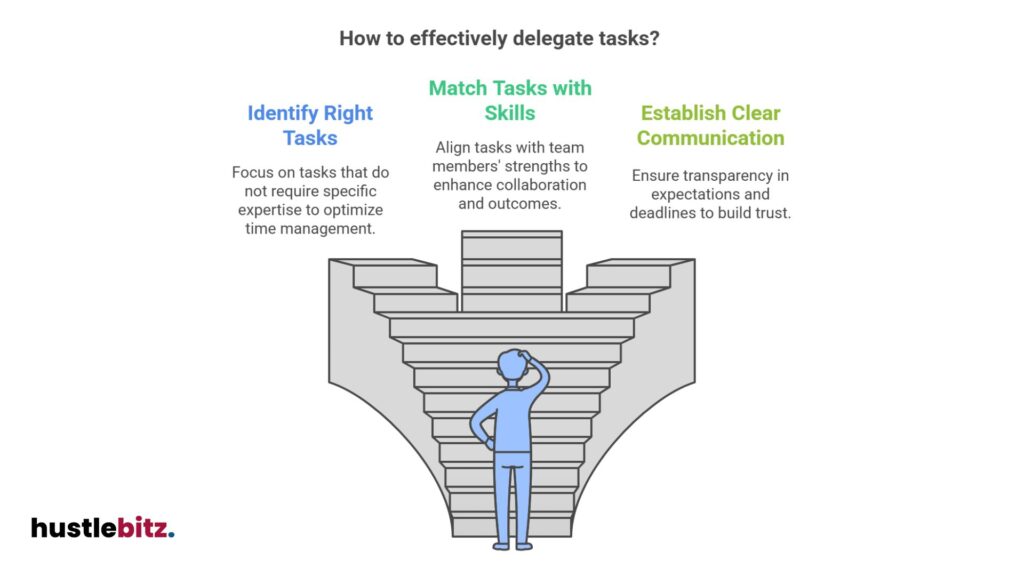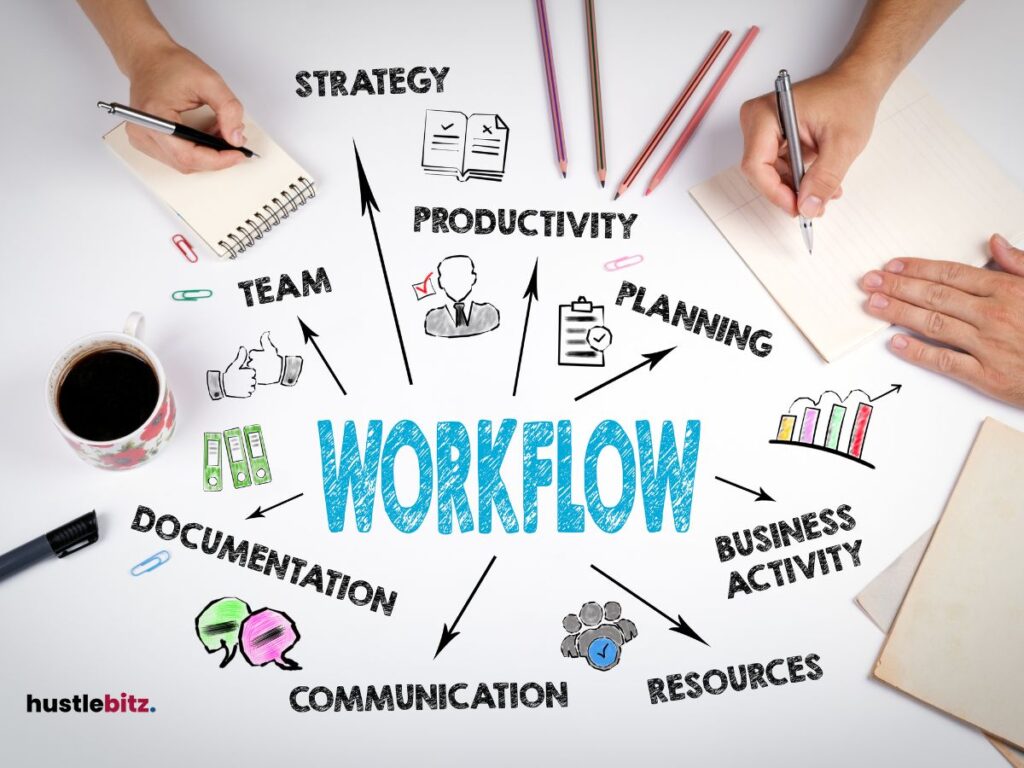To optimize workflows, busy professionals should implement key techniques that enhance productivity. Start with prioritization strategies, such as the Eisenhower Matrix, to distinguish urgent tasks from important ones. Efficient task management involves utilizing project tracking tools and setting realistic deadlines to keep momentum. Automation can significantly streamline repetitive tasks and reduce errors. Additionally, effective delegation and clear communication with team members foster collaboration and skill development. Employing time management tactics like time blocking and energy management can further enhance focus. By exploring these techniques, professionals can refine their processes for optimal performance. Discover more insights to elevate your workflow further.
Key Takeaways
- Prioritize tasks using techniques like the Eisenhower Matrix to distinguish between urgent and important activities for effective resource allocation.
- Implement automation to streamline repetitive tasks, enhancing efficiency and reducing errors across workflows.
- Utilize project management software to organize tasks, timelines, and resource allocation, improving overall team collaboration.
- Regularly monitor performance metrics and gather team feedback to identify bottlenecks and areas for continuous improvement.
- Practice effective delegation by matching tasks with team members’ strengths, ensuring clear communication and empowering skill development.

Understanding Workflow Optimization
Workflow optimization involves the systematic analysis and improvement of processes to enhance efficiency, reduce waste, and ensure that tasks are completed in a timely manner. At the core of this practice is workflow analysis, which examines existing workflows to identify areas of inefficiency. By employing techniques such as process mapping, organizations can visually represent workflows, making it easier to pinpoint redundancies and unclear stages.
A critical aspect of workflow optimization is bottleneck identification. Bottlenecks are points in a process where the flow of work is hindered, leading to delays and decreased productivity. Recognizing these bottlenecks allows teams to implement targeted solutions, thereby streamlining operations and fostering a smoother workflow.
Continuous improvement is another essential principle of workflow optimization. This iterative approach encourages teams to regularly assess and refine their processes based on feedback and performance metrics. By embracing a culture of continuous improvement, organizations can adapt to changing environments and maintain high levels of efficiency.
Team collaboration plays a vital role in successful workflow optimization. When team members work together, sharing insights and strategies, they can collectively identify issues and develop innovative solutions. This collaborative effort not only enhances the overall quality of work but also promotes a sense of ownership among team members.
Prioritization Strategies to Enhance Productivity

Effective prioritization strategies are integral to enhancing productivity, as they enable teams to focus on high-impact tasks while managing their workflow more efficiently.
A fundamental aspect of prioritization involves distinguishing between urgent versus important tasks. Urgent tasks demand immediate attention, whereas important tasks contribute to long-term goals. This differentiation allows professionals to allocate their time and resources effectively.
Daily prioritization methods, such as the Eisenhower Box or the ABCDE method, help individuals categorize tasks based on their urgency and importance. By employing these techniques, busy professionals can streamline their daily activities, ensuring that they tackle the most significant tasks first.
Furthermore, recognizing the impact of deadlines plays a crucial role in prioritization. Tasks with looming deadlines naturally require immediate focus, but they should not overshadow essential long-term objectives.
To maintain alignment with long-term goals, professionals can implement prioritization matrix techniques, which visually categorize tasks based on their urgency and importance. This method aids in decision-making, as it clearly delineates which tasks are critical for overall success.
By consistently applying these prioritization strategies, teams can enhance their productivity, ensuring that they not only meet immediate demands but also progress towards their overarching objectives.
Ultimately, effective prioritization fosters a balanced approach to workload management, enabling professionals to achieve both short-term efficiency and long-term success.
Efficient Task Management

Efficient task management is essential for maximizing productivity and ensuring that team members can focus on their most critical responsibilities. To achieve this, professionals must implement effective strategies that encompass task prioritization, project tracking, deadline management, resource allocation, and workflow mapping.
Task prioritization involves identifying which tasks are most urgent and important, enabling teams to direct their efforts towards high-impact activities. By establishing a clear hierarchy of tasks, professionals can prevent the overwhelming feeling of a long to-do list and instead focus on what truly matters.
Project tracking is another key component of efficient task management. Utilizing project management tools allows teams to monitor progress in real-time, ensuring that everyone is aware of their responsibilities and timelines. This transparency fosters accountability and encourages collaboration among team members.
Deadline management is critical for maintaining momentum and preventing bottlenecks. By setting realistic deadlines and regularly reviewing them, professionals can adjust their strategies as needed to meet targets without sacrificing quality.
Resource allocation is equally important, as it ensures that the right tools, personnel, and materials are available to complete tasks effectively. Properly allocating resources can help alleviate unnecessary stress and improve overall team performance.
The Role of Automation in Workflow Optimization

Integrating automation into task management practices can significantly enhance workflow optimization by streamlining repetitive processes and reducing manual effort. The benefits of automation are manifold, particularly for busy professionals looking to maximize their productivity. However, it is essential to recognize the integration challenges that may arise during the implementation of automated systems.
Here are three key automation benefits to consider:
- Increased Efficiency: Automation minimizes the time spent on mundane tasks, allowing professionals to focus on high-value activities.
- Process Standardization: By automating workflows, organizations can ensure consistent execution of tasks, reducing the chances of errors and variability.
- Enhanced Data Insights: Automation tools often come equipped with advanced analytics, enabling better workflow mapping and decision-making based on real-time data.

Despite these advantages, organizations must navigate integration challenges when adopting automation technologies. Identifying suitable AI applications that align with existing processes is crucial for seamless implementation. Additionally, training staff to adapt to new systems is essential for maximizing the benefits of automation.
Ultimately, embracing automation not only enhances efficiency but also fosters a culture of continuous improvement. By addressing integration challenges head-on and leveraging the power of AI applications, busy professionals can optimize their workflows and drive organizational success.
As the landscape of work continues to evolve, those who prioritize automation will be well-positioned to thrive in an increasingly competitive environment.
Time Management Techniques for Busy Professionals

Mastering time management techniques is essential for busy professionals seeking to enhance productivity and achieve their goals amidst competing priorities.
One effective approach is time blocking, which involves allocating specific time slots for different tasks throughout your day. This method not only helps in minimizing distractions but also ensures that important activities receive the focus they deserve.
In conjunction with time blocking, goal setting is crucial. Establishing clear, measurable goals provides direction and purpose, allowing professionals to concentrate their efforts strategically. By breaking down larger objectives into smaller, actionable tasks, individuals can maintain momentum and stay motivated.
Energy management is another key component of effective time management. Recognizing when you are most productive during the day allows for optimal task allocation. For instance, tackling complex projects during peak energy periods can lead to higher quality output and reduced burnout.
Establishing daily routines can also streamline workflow. A consistent routine fosters discipline and predictability, ultimately reducing decision fatigue and enabling professionals to focus on what truly matters.
Lastly, incorporating reflection practices at the end of each day can significantly enhance time management. By evaluating what worked, what didn’t, and how time was spent, busy professionals can make informed adjustments for future productivity.
Effective Delegation: How to Share the Load

Effective delegation is a critical skill for busy professionals, enabling them to distribute tasks strategically and enhance overall productivity. By sharing the workload, professionals can focus on their core responsibilities while empowering their team members.
Here are three essential strategies for effective delegation:
- Identify the Right Tasks: Evaluate which tasks can be effectively delegated, focusing on those that do not require your specific expertise. This allows for better task sharing and ensures that your time is spent on high-priority responsibilities.
- Match Tasks with Skills: Understand the strengths and weaknesses of your team members. This responsibility distribution helps in assigning tasks that align with individual skill sets, fostering team collaboration and enhancing the likelihood of successful outcomes.
- Establish Clear Communication: Implement robust communication strategies throughout the delegation process. Clearly articulate expectations, deadlines, and desired results. This transparency not only aids in workload balancing but also builds trust among team members.

Tools and Software for Workflow Optimization
Utilizing the right tools and software can significantly streamline workflow processes, enabling professionals to enhance efficiency and focus on their most impactful tasks. A well-chosen suite of tools can make a considerable difference in managing projects, fostering collaboration, and analyzing productivity.
Project management software, for instance, allows teams to track progress, allocate resources, and set deadlines effectively. Collaboration tools enhance communication among team members, ensuring everyone is aligned and informed. Additionally, software integration can help consolidate various applications, reducing the need to switch between multiple platforms and minimizing disruptions.
Mobile applications further enhance workflow by providing access to important tasks and communications on-the-go, allowing professionals to stay connected and productive outside of traditional office environments. Productivity analytics tools provide valuable insights into work patterns, enabling users to identify areas for improvement and optimize their time management.
Here’s a summary of some essential tools and their functions:
| Tool Type | Purpose |
| Project Management | Organizing tasks, timelines, and resources |
| Collaboration Tools | Facilitating team communication and file sharing |
| Mobile Applications | Accessing tasks and updates on-the-go |
| Productivity Analytics | Measuring performance and workflow efficiency |
Incorporating these tools into daily routines can lead to enhanced focus on strategic initiatives, ultimately driving better results and contributing to professional growth.
Monitoring and Adjusting Your Workflow

Ongoing monitoring and adjustment of workflows are essential for maintaining operational efficiency and adapting to evolving business needs. By implementing robust monitoring practices, professionals can ensure their workflows remain effective and responsive.
Here are three key strategies to enhance your workflow monitoring:
- Utilize Performance Metrics: Establish clear performance metrics that align with your business goals. Metrics such as task completion rates, time spent on tasks, and resource utilization provide quantifiable data that can guide adjustments.
- Gather Workflow Feedback: Regularly solicit feedback from team members regarding the workflow processes. This input is invaluable for identifying areas of frustration or inefficiency, thus facilitating timely modifications.
- Identify Bottlenecks: Conduct routine analyses to pinpoint bottlenecks in your workflow. Understanding where delays occur allows for targeted interventions, ensuring smoother and more efficient operations.
These strategies foster a culture of continuous improvement, where adaptability strategies are at the forefront.
By staying proactive in adjusting workflows, businesses can not only respond effectively to challenges but also anticipate future needs. The integration of workflow feedback and performance metrics creates a dynamic environment conducive to innovation and efficiency.
Ultimately, the aim is to cultivate a workflow that not only meets current demands but is also flexible enough to evolve as necessary, ensuring sustained success in a competitive landscape.
Final Thoughts
Optimizing workflows is essential for busy professionals to boost productivity and achieve their objectives efficiently. By prioritizing tasks, utilizing automation, and employing effective task management techniques, professionals can streamline their processes and focus on high-impact activities. Embracing tools and software for project tracking, maintaining clear communication, and regularly monitoring and adjusting workflows ensure that tasks are completed effectively and adapt to changing needs. Implementing these strategies fosters a more organized and productive work environment, positioning professionals for sustained success.




